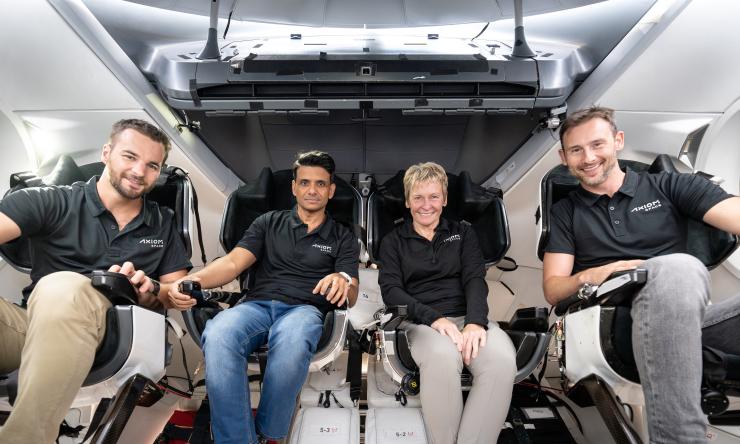TRISH to lead innovative human health and performance research on upcoming Ax-4 Mission
The Translational Research Institute for Space Health (TRISH) will conduct a suite of human health and performance research projects during the upcoming Axiom Mission 4 (Ax-4) to the International Space Station, which is scheduled to launch May 2025.
The selected TRISH research projects are designed to enhance understanding of the human experience in space and inform the development of high-impact scientific and technological solutions to help humans thrive on future space missions. Each project is part of TRISH’s commercial spaceflight health research program, EXPAND (Enhancing eXploration Platforms and ANalog Definition). Led by researchers from institutions nationwide, these projects will explore critical space health and performance topics, including space motion sickness, sleep disturbances, changes to the genome, cognitive function, and eye and brain health.
TRISH is funded by NASA’s Human Research Program (HRP) to help shape the future of human performance with the latest advancements in space health. The EXPAND projects join NASA’s portfolio of human research studies that will collect data from Ax-4 crew members.
“Our collaboration with Axiom Space continues to be pivotal in advancing our understanding of human health and performance in space,” said Jimmy Wu, deputy director and chief engineer at TRISH, and assistant professor in the Center for Space Medicine at Baylor. “The research conducted during Ax-4 will provide invaluable insights into how the human body adapts to the unique stressors of space, pushing the boundaries of what we know about living and working in space. This work will not only enhance astronaut health and performance but will also have lasting impacts on improving health and wellbeing on Earth and as we venture further into space, including to the Moon and Mars.”
Ax-4 marks Axiom Space’s fourth commercial astronaut mission to the International Space Station, where the four-person crew will spend an estimated up to 14 days conducting research and engaging in technology demonstrations. During their time aboard, they will focus on microgravity experiments, advancing scientific knowledge and fostering international collaboration in space exploration. This mission is a key milestone in commercial space travel, continuing to expand private, public and international participation on the space station.
"Since Axiom Mission 1, our ongoing collaboration with TRISH has been valuable in unraveling the complexities of human adaptation to space,” said Axiom Space Chief Scientist Dr. Lucie Low. By systematically collecting and analyzing data on physiology, cognitive performance, genetic expression and more, we are not only enhancing the safety and effectiveness of commercial human spaceflight but also unlocking important insights for Earth-based medicine. This research has the potential to impact treatments for eye and movement disorders and address the cognitive and emotional challenges of isolated and stressful environments, both in space and on Earth."
The TRISH EXPAND biomedical research projects for Ax-4 include:
- Cognitive and Physiologic Responses in Commercial Space Crew on Short-Duration Missions, Mathias Basner, M.D., Ph.D., M.S., University of Pennsylvania Perelman School of Medicine
- Standardized research questionnaires, TRISH
- SANS Surveillance, TRISH
- Otolith and Posture Evaluation II, Mark Shelhamer, Sc.D., Johns Hopkins University
- Space Omics + BioBank, Richard Gibbs, Ph.D., Baylor College of Medicine
Complementing these projects are other NASA HRP studies that will be performed by Ax-4 crew. These include efforts to collect a consistent set of physiological and psychological measurements from astronauts, surveys of crewmembers’ potential discomfort during re-entry to Earth, and routine surveys of astronauts physical and mental health after they land back on Earth.







 Credit
Credit


